Decision Making in Business Environments
VerifiedAdded on 2020/03/02
|15
|4215
|296
AI Summary
The assignment delves into the complexities of decision making within business contexts. It analyzes diverse decision-making models, evaluating their effectiveness and applicability to real-world scenarios. The discussion encompasses factors influencing decision processes, including intuition, analytical frameworks, and group dynamics. Furthermore, the assignment considers the ethical implications of decision-making in organizational settings.
Contribute Materials
Your contribution can guide someone’s learning journey. Share your
documents today.
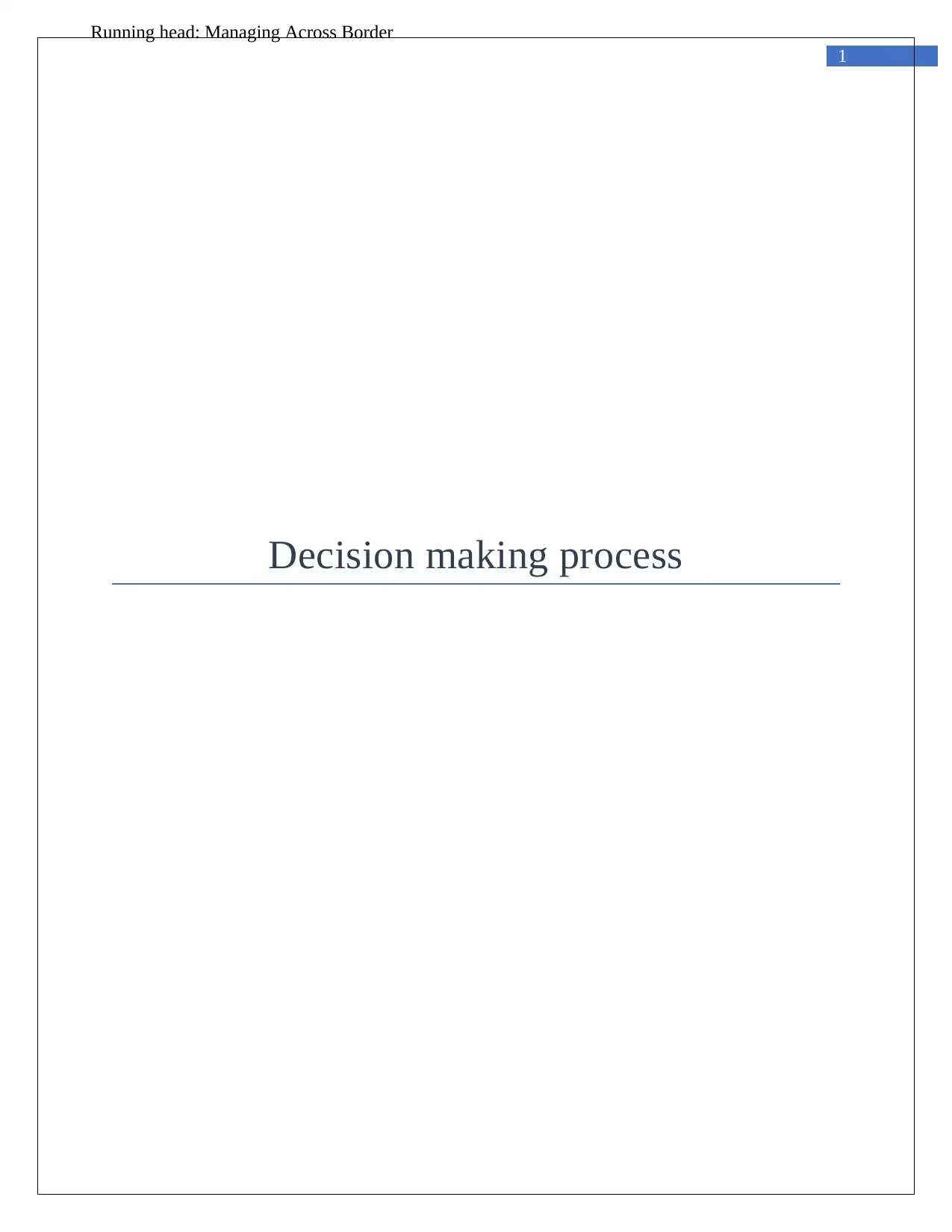
1
Running head: Managing Across Border
Decision making process
Running head: Managing Across Border
Decision making process
Secure Best Marks with AI Grader
Need help grading? Try our AI Grader for instant feedback on your assignments.
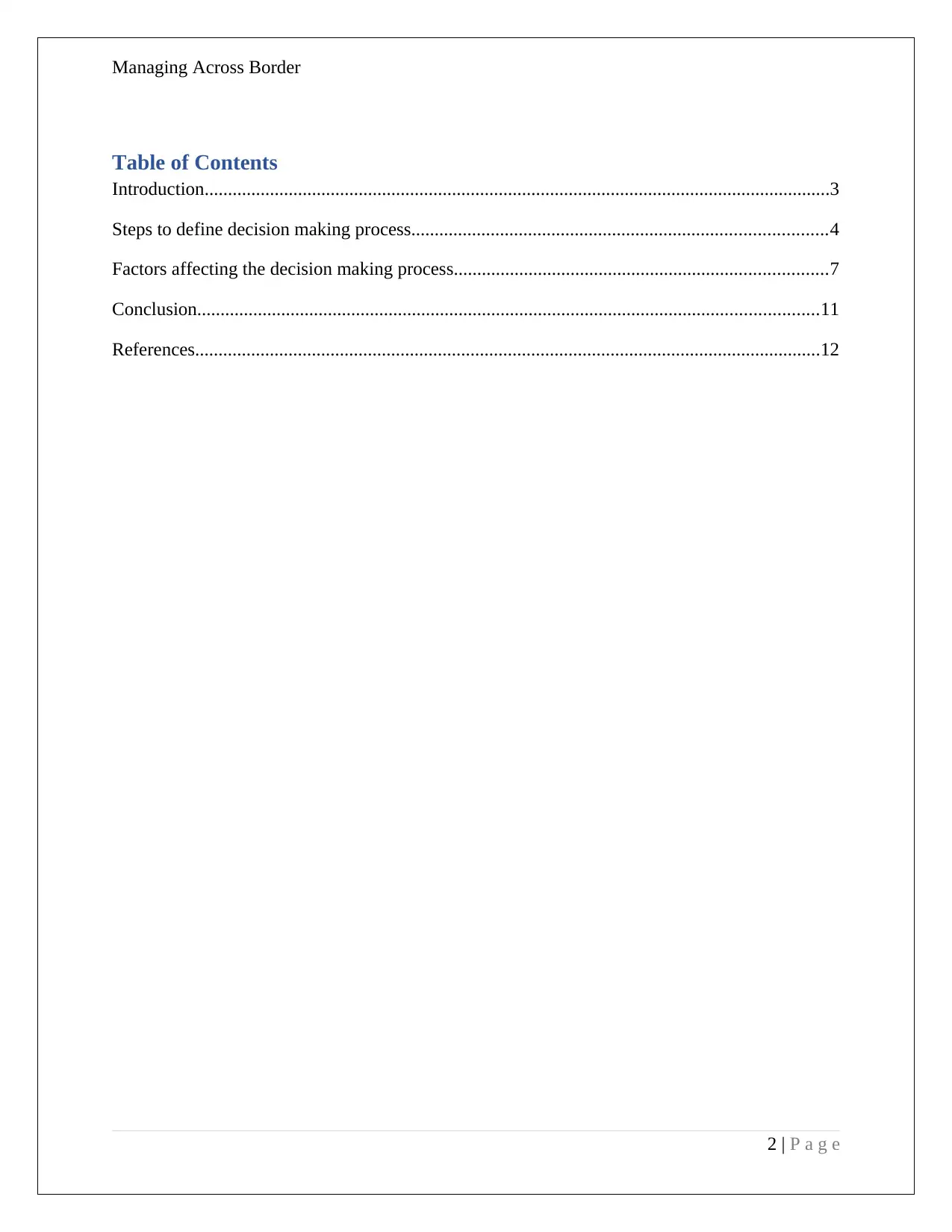
Managing Across Border
Table of Contents
Introduction......................................................................................................................................3
Steps to define decision making process.........................................................................................4
Factors affecting the decision making process................................................................................7
Conclusion.....................................................................................................................................11
References......................................................................................................................................12
2 | P a g e
Table of Contents
Introduction......................................................................................................................................3
Steps to define decision making process.........................................................................................4
Factors affecting the decision making process................................................................................7
Conclusion.....................................................................................................................................11
References......................................................................................................................................12
2 | P a g e
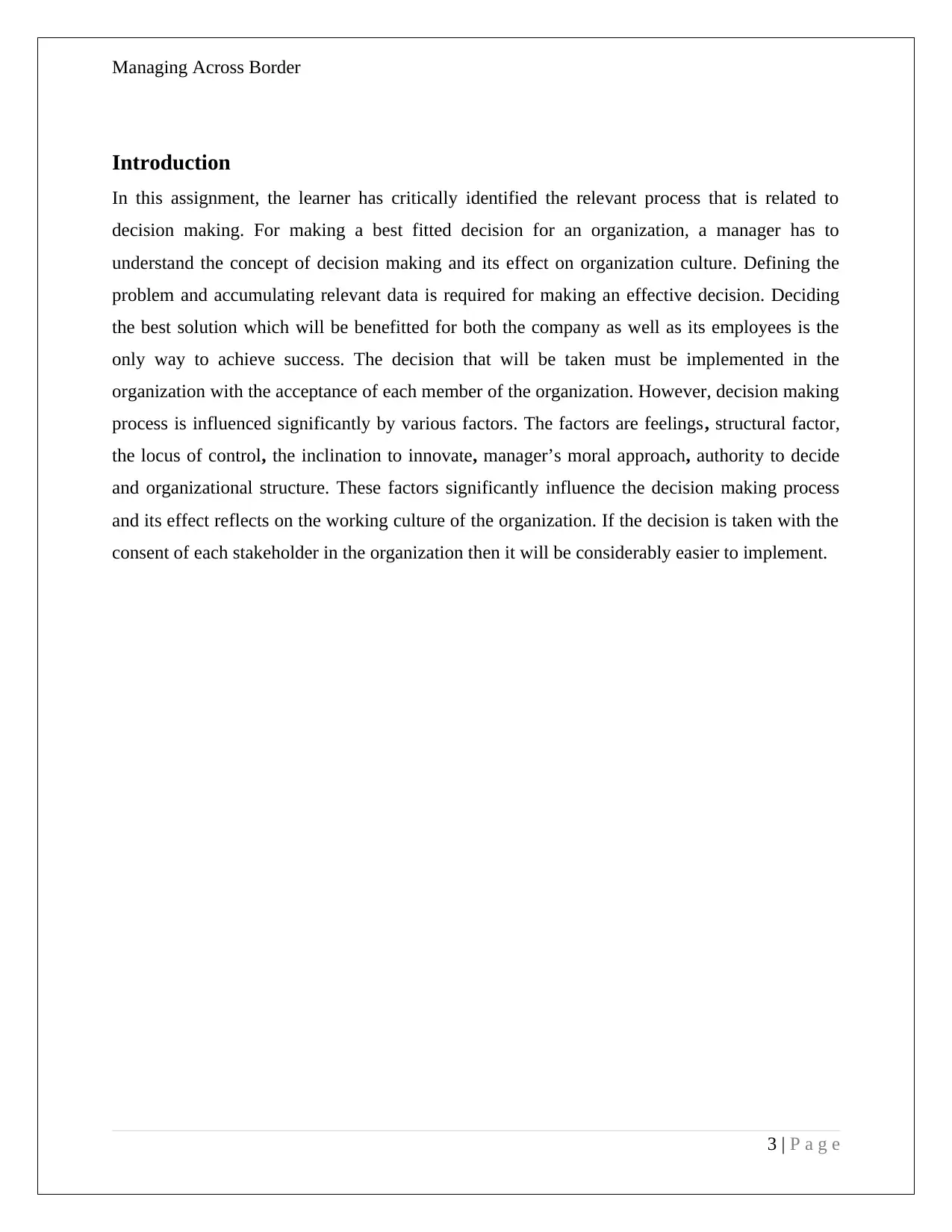
Managing Across Border
Introduction
In this assignment, the learner has critically identified the relevant process that is related to
decision making. For making a best fitted decision for an organization, a manager has to
understand the concept of decision making and its effect on organization culture. Defining the
problem and accumulating relevant data is required for making an effective decision. Deciding
the best solution which will be benefitted for both the company as well as its employees is the
only way to achieve success. The decision that will be taken must be implemented in the
organization with the acceptance of each member of the organization. However, decision making
process is influenced significantly by various factors. The factors are feelings, structural factor,
the locus of control, the inclination to innovate, manager’s moral approach, authority to decide
and organizational structure. These factors significantly influence the decision making process
and its effect reflects on the working culture of the organization. If the decision is taken with the
consent of each stakeholder in the organization then it will be considerably easier to implement.
3 | P a g e
Introduction
In this assignment, the learner has critically identified the relevant process that is related to
decision making. For making a best fitted decision for an organization, a manager has to
understand the concept of decision making and its effect on organization culture. Defining the
problem and accumulating relevant data is required for making an effective decision. Deciding
the best solution which will be benefitted for both the company as well as its employees is the
only way to achieve success. The decision that will be taken must be implemented in the
organization with the acceptance of each member of the organization. However, decision making
process is influenced significantly by various factors. The factors are feelings, structural factor,
the locus of control, the inclination to innovate, manager’s moral approach, authority to decide
and organizational structure. These factors significantly influence the decision making process
and its effect reflects on the working culture of the organization. If the decision is taken with the
consent of each stakeholder in the organization then it will be considerably easier to implement.
3 | P a g e
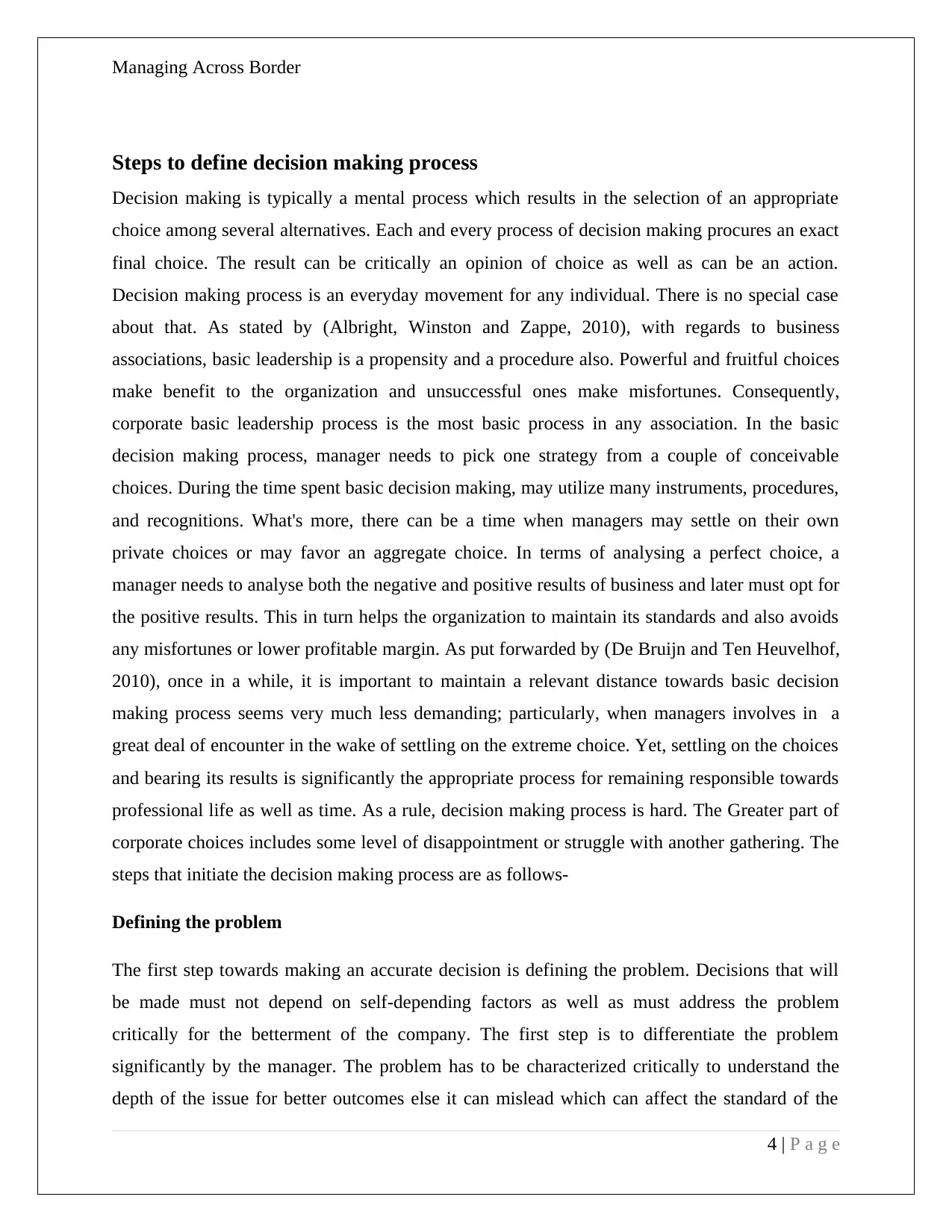
Managing Across Border
Steps to define decision making process
Decision making is typically a mental process which results in the selection of an appropriate
choice among several alternatives. Each and every process of decision making procures an exact
final choice. The result can be critically an opinion of choice as well as can be an action.
Decision making process is an everyday movement for any individual. There is no special case
about that. As stated by (Albright, Winston and Zappe, 2010), with regards to business
associations, basic leadership is a propensity and a procedure also. Powerful and fruitful choices
make benefit to the organization and unsuccessful ones make misfortunes. Consequently,
corporate basic leadership process is the most basic process in any association. In the basic
decision making process, manager needs to pick one strategy from a couple of conceivable
choices. During the time spent basic decision making, may utilize many instruments, procedures,
and recognitions. What's more, there can be a time when managers may settle on their own
private choices or may favor an aggregate choice. In terms of analysing a perfect choice, a
manager needs to analyse both the negative and positive results of business and later must opt for
the positive results. This in turn helps the organization to maintain its standards and also avoids
any misfortunes or lower profitable margin. As put forwarded by (De Bruijn and Ten Heuvelhof,
2010), once in a while, it is important to maintain a relevant distance towards basic decision
making process seems very much less demanding; particularly, when managers involves in a
great deal of encounter in the wake of settling on the extreme choice. Yet, settling on the choices
and bearing its results is significantly the appropriate process for remaining responsible towards
professional life as well as time. As a rule, decision making process is hard. The Greater part of
corporate choices includes some level of disappointment or struggle with another gathering. The
steps that initiate the decision making process are as follows-
Defining the problem
The first step towards making an accurate decision is defining the problem. Decisions that will
be made must not depend on self-depending factors as well as must address the problem
critically for the betterment of the company. The first step is to differentiate the problem
significantly by the manager. The problem has to be characterized critically to understand the
depth of the issue for better outcomes else it can mislead which can affect the standard of the
4 | P a g e
Steps to define decision making process
Decision making is typically a mental process which results in the selection of an appropriate
choice among several alternatives. Each and every process of decision making procures an exact
final choice. The result can be critically an opinion of choice as well as can be an action.
Decision making process is an everyday movement for any individual. There is no special case
about that. As stated by (Albright, Winston and Zappe, 2010), with regards to business
associations, basic leadership is a propensity and a procedure also. Powerful and fruitful choices
make benefit to the organization and unsuccessful ones make misfortunes. Consequently,
corporate basic leadership process is the most basic process in any association. In the basic
decision making process, manager needs to pick one strategy from a couple of conceivable
choices. During the time spent basic decision making, may utilize many instruments, procedures,
and recognitions. What's more, there can be a time when managers may settle on their own
private choices or may favor an aggregate choice. In terms of analysing a perfect choice, a
manager needs to analyse both the negative and positive results of business and later must opt for
the positive results. This in turn helps the organization to maintain its standards and also avoids
any misfortunes or lower profitable margin. As put forwarded by (De Bruijn and Ten Heuvelhof,
2010), once in a while, it is important to maintain a relevant distance towards basic decision
making process seems very much less demanding; particularly, when managers involves in a
great deal of encounter in the wake of settling on the extreme choice. Yet, settling on the choices
and bearing its results is significantly the appropriate process for remaining responsible towards
professional life as well as time. As a rule, decision making process is hard. The Greater part of
corporate choices includes some level of disappointment or struggle with another gathering. The
steps that initiate the decision making process are as follows-
Defining the problem
The first step towards making an accurate decision is defining the problem. Decisions that will
be made must not depend on self-depending factors as well as must address the problem
critically for the betterment of the company. The first step is to differentiate the problem
significantly by the manager. The problem has to be characterized critically to understand the
depth of the issue for better outcomes else it can mislead which can affect the standard of the
4 | P a g e
Secure Best Marks with AI Grader
Need help grading? Try our AI Grader for instant feedback on your assignments.
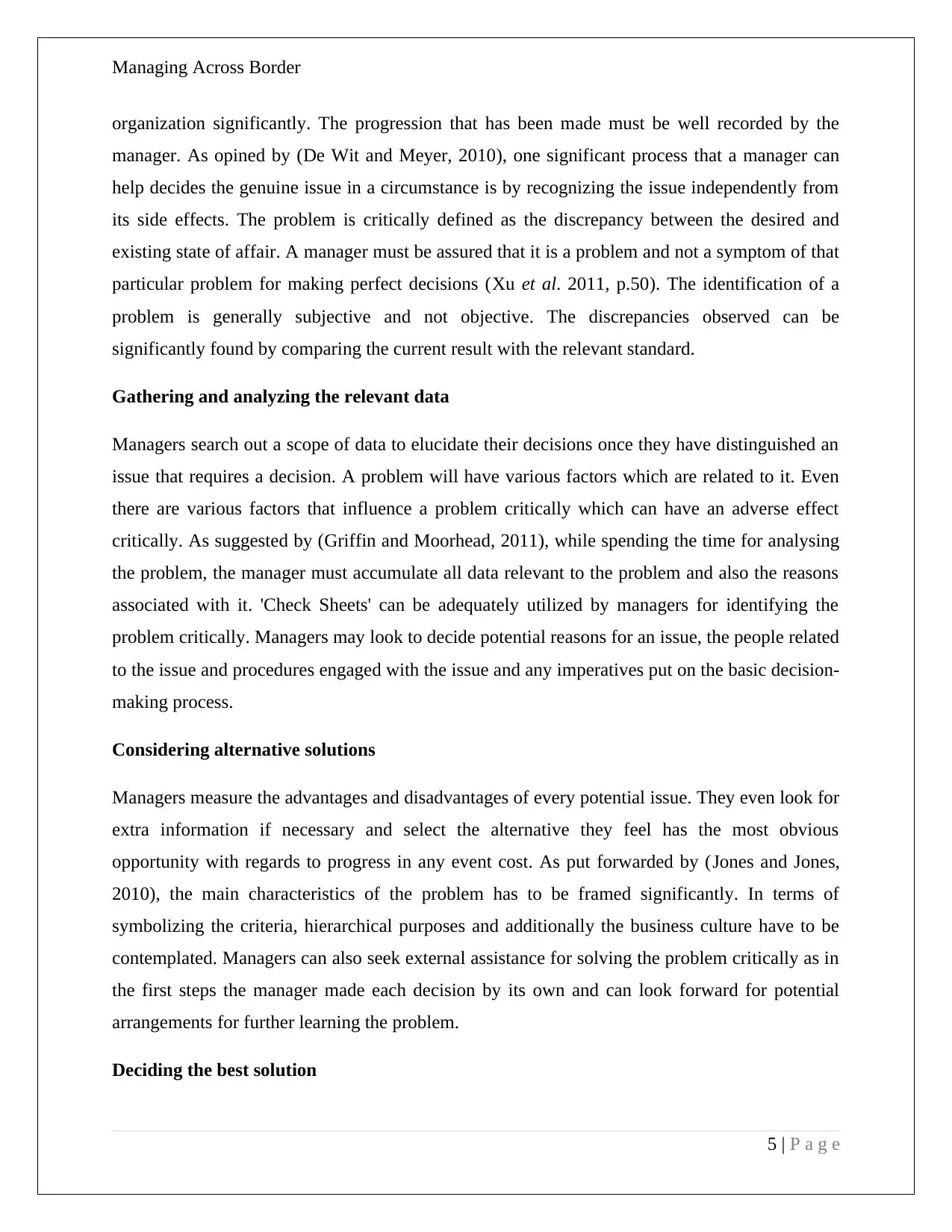
Managing Across Border
organization significantly. The progression that has been made must be well recorded by the
manager. As opined by (De Wit and Meyer, 2010), one significant process that a manager can
help decides the genuine issue in a circumstance is by recognizing the issue independently from
its side effects. The problem is critically defined as the discrepancy between the desired and
existing state of affair. A manager must be assured that it is a problem and not a symptom of that
particular problem for making perfect decisions (Xu et al. 2011, p.50). The identification of a
problem is generally subjective and not objective. The discrepancies observed can be
significantly found by comparing the current result with the relevant standard.
Gathering and analyzing the relevant data
Managers search out a scope of data to elucidate their decisions once they have distinguished an
issue that requires a decision. A problem will have various factors which are related to it. Even
there are various factors that influence a problem critically which can have an adverse effect
critically. As suggested by (Griffin and Moorhead, 2011), while spending the time for analysing
the problem, the manager must accumulate all data relevant to the problem and also the reasons
associated with it. 'Check Sheets' can be adequately utilized by managers for identifying the
problem critically. Managers may look to decide potential reasons for an issue, the people related
to the issue and procedures engaged with the issue and any imperatives put on the basic decision-
making process.
Considering alternative solutions
Managers measure the advantages and disadvantages of every potential issue. They even look for
extra information if necessary and select the alternative they feel has the most obvious
opportunity with regards to progress in any event cost. As put forwarded by (Jones and Jones,
2010), the main characteristics of the problem has to be framed significantly. In terms of
symbolizing the criteria, hierarchical purposes and additionally the business culture have to be
contemplated. Managers can also seek external assistance for solving the problem critically as in
the first steps the manager made each decision by its own and can look forward for potential
arrangements for further learning the problem.
Deciding the best solution
5 | P a g e
organization significantly. The progression that has been made must be well recorded by the
manager. As opined by (De Wit and Meyer, 2010), one significant process that a manager can
help decides the genuine issue in a circumstance is by recognizing the issue independently from
its side effects. The problem is critically defined as the discrepancy between the desired and
existing state of affair. A manager must be assured that it is a problem and not a symptom of that
particular problem for making perfect decisions (Xu et al. 2011, p.50). The identification of a
problem is generally subjective and not objective. The discrepancies observed can be
significantly found by comparing the current result with the relevant standard.
Gathering and analyzing the relevant data
Managers search out a scope of data to elucidate their decisions once they have distinguished an
issue that requires a decision. A problem will have various factors which are related to it. Even
there are various factors that influence a problem critically which can have an adverse effect
critically. As suggested by (Griffin and Moorhead, 2011), while spending the time for analysing
the problem, the manager must accumulate all data relevant to the problem and also the reasons
associated with it. 'Check Sheets' can be adequately utilized by managers for identifying the
problem critically. Managers may look to decide potential reasons for an issue, the people related
to the issue and procedures engaged with the issue and any imperatives put on the basic decision-
making process.
Considering alternative solutions
Managers measure the advantages and disadvantages of every potential issue. They even look for
extra information if necessary and select the alternative they feel has the most obvious
opportunity with regards to progress in any event cost. As put forwarded by (Jones and Jones,
2010), the main characteristics of the problem has to be framed significantly. In terms of
symbolizing the criteria, hierarchical purposes and additionally the business culture have to be
contemplated. Managers can also seek external assistance for solving the problem critically as in
the first steps the manager made each decision by its own and can look forward for potential
arrangements for further learning the problem.
Deciding the best solution
5 | P a g e
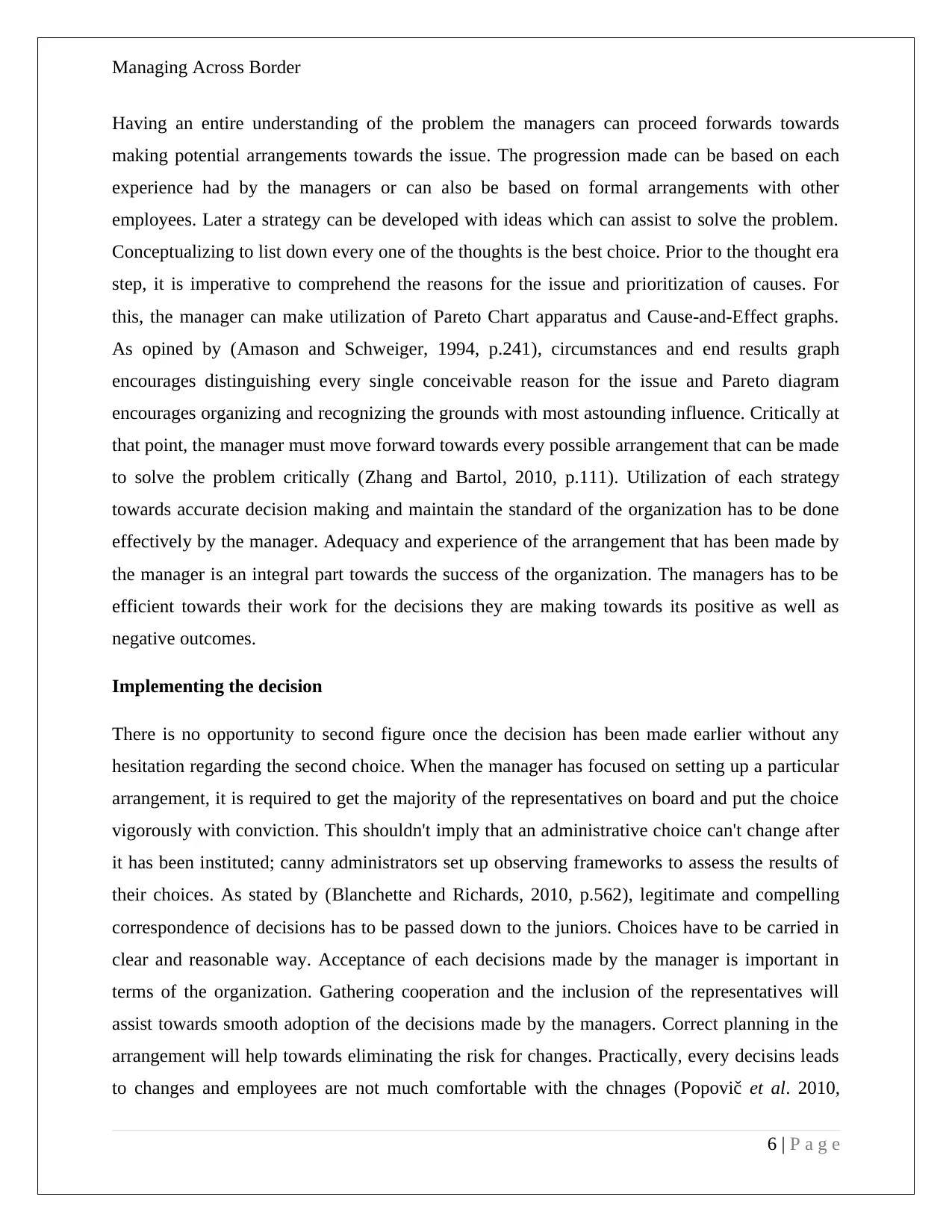
Managing Across Border
Having an entire understanding of the problem the managers can proceed forwards towards
making potential arrangements towards the issue. The progression made can be based on each
experience had by the managers or can also be based on formal arrangements with other
employees. Later a strategy can be developed with ideas which can assist to solve the problem.
Conceptualizing to list down every one of the thoughts is the best choice. Prior to the thought era
step, it is imperative to comprehend the reasons for the issue and prioritization of causes. For
this, the manager can make utilization of Pareto Chart apparatus and Cause-and-Effect graphs.
As opined by (Amason and Schweiger, 1994, p.241), circumstances and end results graph
encourages distinguishing every single conceivable reason for the issue and Pareto diagram
encourages organizing and recognizing the grounds with most astounding influence. Critically at
that point, the manager must move forward towards every possible arrangement that can be made
to solve the problem critically (Zhang and Bartol, 2010, p.111). Utilization of each strategy
towards accurate decision making and maintain the standard of the organization has to be done
effectively by the manager. Adequacy and experience of the arrangement that has been made by
the manager is an integral part towards the success of the organization. The managers has to be
efficient towards their work for the decisions they are making towards its positive as well as
negative outcomes.
Implementing the decision
There is no opportunity to second figure once the decision has been made earlier without any
hesitation regarding the second choice. When the manager has focused on setting up a particular
arrangement, it is required to get the majority of the representatives on board and put the choice
vigorously with conviction. This shouldn't imply that an administrative choice can't change after
it has been instituted; canny administrators set up observing frameworks to assess the results of
their choices. As stated by (Blanchette and Richards, 2010, p.562), legitimate and compelling
correspondence of decisions has to be passed down to the juniors. Choices have to be carried in
clear and reasonable way. Acceptance of each decisions made by the manager is important in
terms of the organization. Gathering cooperation and the inclusion of the representatives will
assist towards smooth adoption of the decisions made by the managers. Correct planning in the
arrangement will help towards eliminating the risk for changes. Practically, every decisins leads
to changes and employees are not much comfortable with the chnages (Popovič et al. 2010,
6 | P a g e
Having an entire understanding of the problem the managers can proceed forwards towards
making potential arrangements towards the issue. The progression made can be based on each
experience had by the managers or can also be based on formal arrangements with other
employees. Later a strategy can be developed with ideas which can assist to solve the problem.
Conceptualizing to list down every one of the thoughts is the best choice. Prior to the thought era
step, it is imperative to comprehend the reasons for the issue and prioritization of causes. For
this, the manager can make utilization of Pareto Chart apparatus and Cause-and-Effect graphs.
As opined by (Amason and Schweiger, 1994, p.241), circumstances and end results graph
encourages distinguishing every single conceivable reason for the issue and Pareto diagram
encourages organizing and recognizing the grounds with most astounding influence. Critically at
that point, the manager must move forward towards every possible arrangement that can be made
to solve the problem critically (Zhang and Bartol, 2010, p.111). Utilization of each strategy
towards accurate decision making and maintain the standard of the organization has to be done
effectively by the manager. Adequacy and experience of the arrangement that has been made by
the manager is an integral part towards the success of the organization. The managers has to be
efficient towards their work for the decisions they are making towards its positive as well as
negative outcomes.
Implementing the decision
There is no opportunity to second figure once the decision has been made earlier without any
hesitation regarding the second choice. When the manager has focused on setting up a particular
arrangement, it is required to get the majority of the representatives on board and put the choice
vigorously with conviction. This shouldn't imply that an administrative choice can't change after
it has been instituted; canny administrators set up observing frameworks to assess the results of
their choices. As stated by (Blanchette and Richards, 2010, p.562), legitimate and compelling
correspondence of decisions has to be passed down to the juniors. Choices have to be carried in
clear and reasonable way. Acceptance of each decisions made by the manager is important in
terms of the organization. Gathering cooperation and the inclusion of the representatives will
assist towards smooth adoption of the decisions made by the managers. Correct planning in the
arrangement will help towards eliminating the risk for changes. Practically, every decisins leads
to changes and employees are not much comfortable with the chnages (Popovič et al. 2010,
6 | P a g e

Managing Across Border
p.730). However, implementing the best possible decisions which is well accepted by each
members can lead to successful integration of the decision.
7 | P a g e
p.730). However, implementing the best possible decisions which is well accepted by each
members can lead to successful integration of the decision.
7 | P a g e
Paraphrase This Document
Need a fresh take? Get an instant paraphrase of this document with our AI Paraphraser
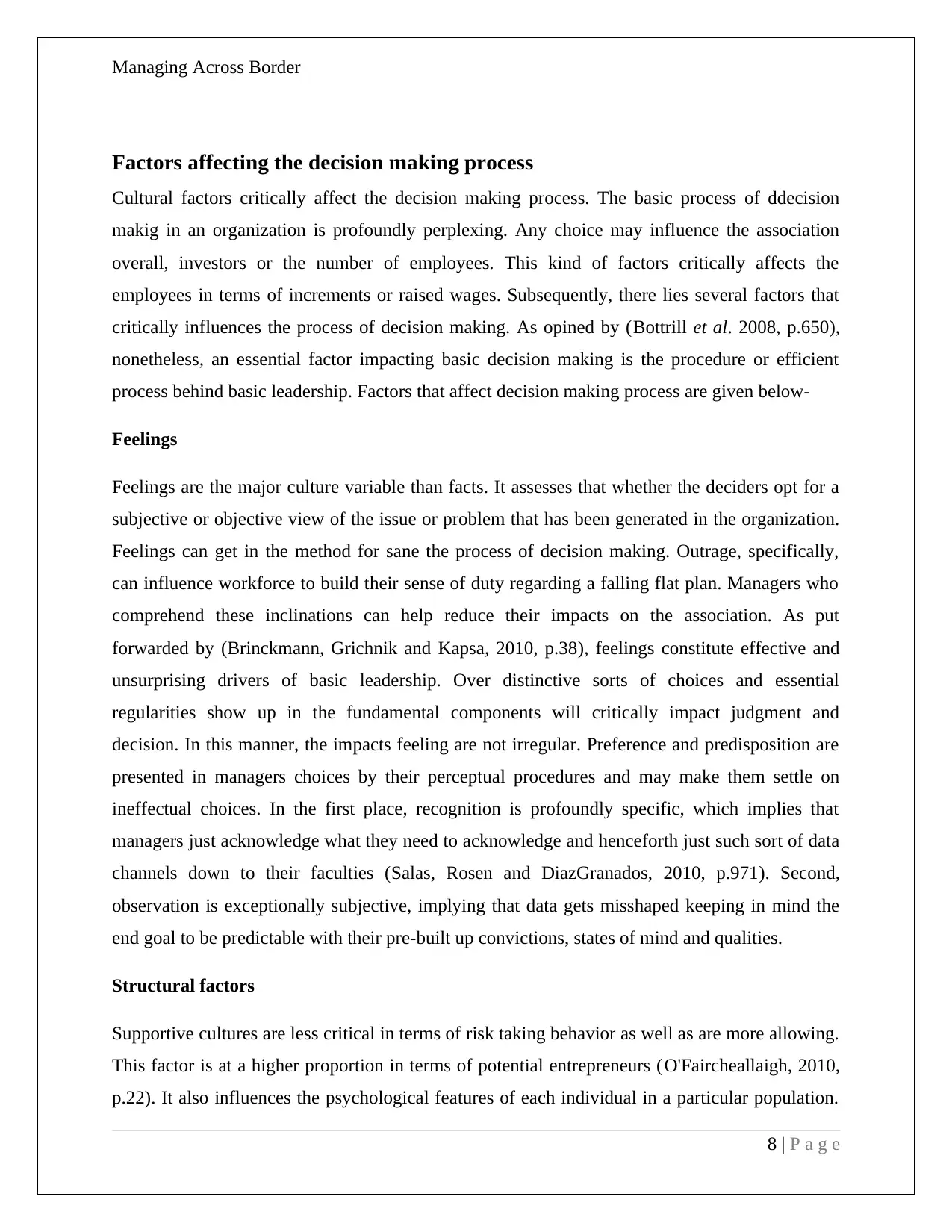
Managing Across Border
Factors affecting the decision making process
Cultural factors critically affect the decision making process. The basic process of ddecision
makig in an organization is profoundly perplexing. Any choice may influence the association
overall, investors or the number of employees. This kind of factors critically affects the
employees in terms of increments or raised wages. Subsequently, there lies several factors that
critically influences the process of decision making. As opined by (Bottrill et al. 2008, p.650),
nonetheless, an essential factor impacting basic decision making is the procedure or efficient
process behind basic leadership. Factors that affect decision making process are given below-
Feelings
Feelings are the major culture variable than facts. It assesses that whether the deciders opt for a
subjective or objective view of the issue or problem that has been generated in the organization.
Feelings can get in the method for sane the process of decision making. Outrage, specifically,
can influence workforce to build their sense of duty regarding a falling flat plan. Managers who
comprehend these inclinations can help reduce their impacts on the association. As put
forwarded by (Brinckmann, Grichnik and Kapsa, 2010, p.38), feelings constitute effective and
unsurprising drivers of basic leadership. Over distinctive sorts of choices and essential
regularities show up in the fundamental components will critically impact judgment and
decision. In this manner, the impacts feeling are not irregular. Preference and predisposition are
presented in managers choices by their perceptual procedures and may make them settle on
ineffectual choices. In the first place, recognition is profoundly specific, which implies that
managers just acknowledge what they need to acknowledge and henceforth just such sort of data
channels down to their faculties (Salas, Rosen and DiazGranados, 2010, p.971). Second,
observation is exceptionally subjective, implying that data gets misshaped keeping in mind the
end goal to be predictable with their pre-built up convictions, states of mind and qualities.
Structural factors
Supportive cultures are less critical in terms of risk taking behavior as well as are more allowing.
This factor is at a higher proportion in terms of potential entrepreneurs (O'Faircheallaigh, 2010,
p.22). It also influences the psychological features of each individual in a particular population.
8 | P a g e
Factors affecting the decision making process
Cultural factors critically affect the decision making process. The basic process of ddecision
makig in an organization is profoundly perplexing. Any choice may influence the association
overall, investors or the number of employees. This kind of factors critically affects the
employees in terms of increments or raised wages. Subsequently, there lies several factors that
critically influences the process of decision making. As opined by (Bottrill et al. 2008, p.650),
nonetheless, an essential factor impacting basic decision making is the procedure or efficient
process behind basic leadership. Factors that affect decision making process are given below-
Feelings
Feelings are the major culture variable than facts. It assesses that whether the deciders opt for a
subjective or objective view of the issue or problem that has been generated in the organization.
Feelings can get in the method for sane the process of decision making. Outrage, specifically,
can influence workforce to build their sense of duty regarding a falling flat plan. Managers who
comprehend these inclinations can help reduce their impacts on the association. As put
forwarded by (Brinckmann, Grichnik and Kapsa, 2010, p.38), feelings constitute effective and
unsurprising drivers of basic leadership. Over distinctive sorts of choices and essential
regularities show up in the fundamental components will critically impact judgment and
decision. In this manner, the impacts feeling are not irregular. Preference and predisposition are
presented in managers choices by their perceptual procedures and may make them settle on
ineffectual choices. In the first place, recognition is profoundly specific, which implies that
managers just acknowledge what they need to acknowledge and henceforth just such sort of data
channels down to their faculties (Salas, Rosen and DiazGranados, 2010, p.971). Second,
observation is exceptionally subjective, implying that data gets misshaped keeping in mind the
end goal to be predictable with their pre-built up convictions, states of mind and qualities.
Structural factors
Supportive cultures are less critical in terms of risk taking behavior as well as are more allowing.
This factor is at a higher proportion in terms of potential entrepreneurs (O'Faircheallaigh, 2010,
p.22). It also influences the psychological features of each individual in a particular population.
8 | P a g e
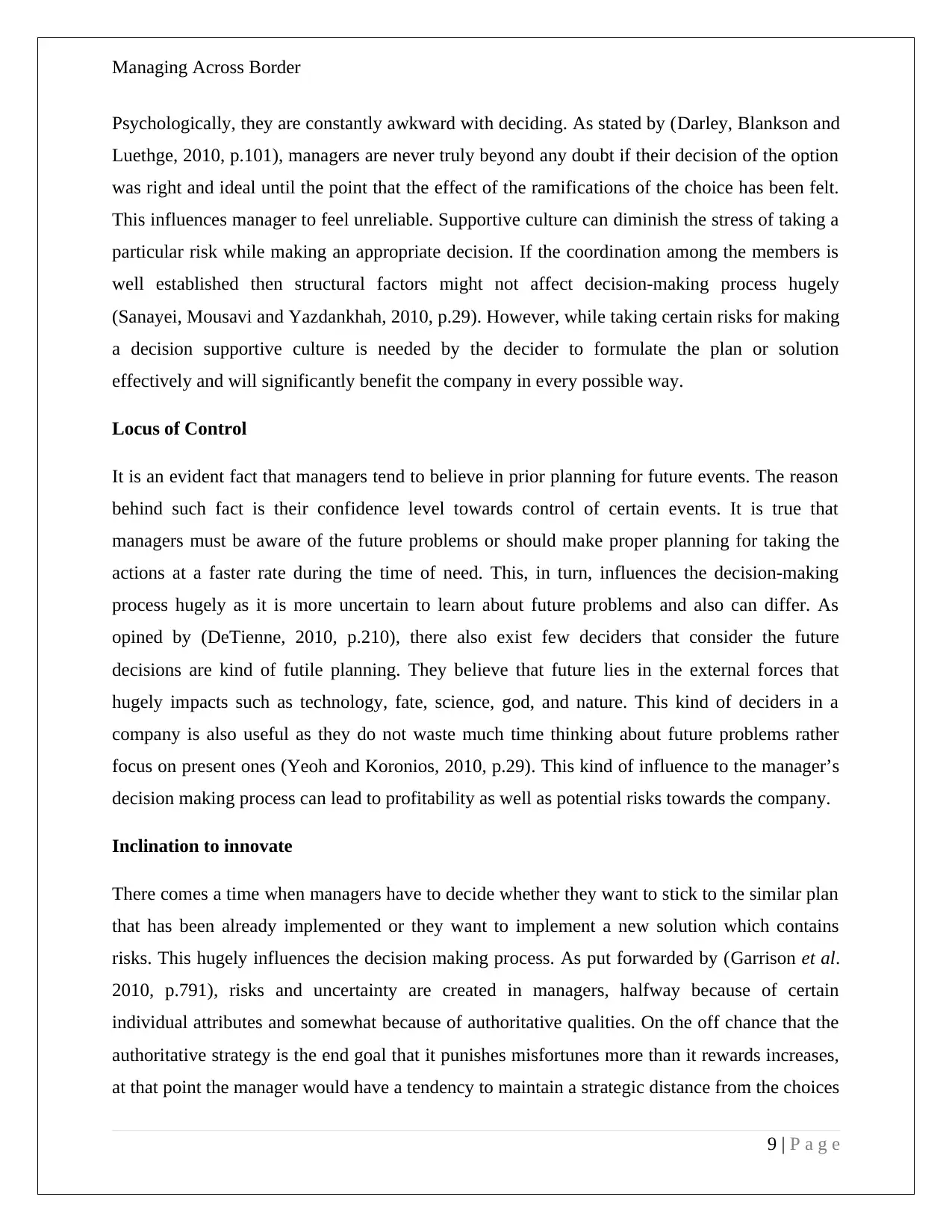
Managing Across Border
Psychologically, they are constantly awkward with deciding. As stated by (Darley, Blankson and
Luethge, 2010, p.101), managers are never truly beyond any doubt if their decision of the option
was right and ideal until the point that the effect of the ramifications of the choice has been felt.
This influences manager to feel unreliable. Supportive culture can diminish the stress of taking a
particular risk while making an appropriate decision. If the coordination among the members is
well established then structural factors might not affect decision-making process hugely
(Sanayei, Mousavi and Yazdankhah, 2010, p.29). However, while taking certain risks for making
a decision supportive culture is needed by the decider to formulate the plan or solution
effectively and will significantly benefit the company in every possible way.
Locus of Control
It is an evident fact that managers tend to believe in prior planning for future events. The reason
behind such fact is their confidence level towards control of certain events. It is true that
managers must be aware of the future problems or should make proper planning for taking the
actions at a faster rate during the time of need. This, in turn, influences the decision-making
process hugely as it is more uncertain to learn about future problems and also can differ. As
opined by (DeTienne, 2010, p.210), there also exist few deciders that consider the future
decisions are kind of futile planning. They believe that future lies in the external forces that
hugely impacts such as technology, fate, science, god, and nature. This kind of deciders in a
company is also useful as they do not waste much time thinking about future problems rather
focus on present ones (Yeoh and Koronios, 2010, p.29). This kind of influence to the manager’s
decision making process can lead to profitability as well as potential risks towards the company.
Inclination to innovate
There comes a time when managers have to decide whether they want to stick to the similar plan
that has been already implemented or they want to implement a new solution which contains
risks. This hugely influences the decision making process. As put forwarded by (Garrison et al.
2010, p.791), risks and uncertainty are created in managers, halfway because of certain
individual attributes and somewhat because of authoritative qualities. On the off chance that the
authoritative strategy is the end goal that it punishes misfortunes more than it rewards increases,
at that point the manager would have a tendency to maintain a strategic distance from the choices
9 | P a g e
Psychologically, they are constantly awkward with deciding. As stated by (Darley, Blankson and
Luethge, 2010, p.101), managers are never truly beyond any doubt if their decision of the option
was right and ideal until the point that the effect of the ramifications of the choice has been felt.
This influences manager to feel unreliable. Supportive culture can diminish the stress of taking a
particular risk while making an appropriate decision. If the coordination among the members is
well established then structural factors might not affect decision-making process hugely
(Sanayei, Mousavi and Yazdankhah, 2010, p.29). However, while taking certain risks for making
a decision supportive culture is needed by the decider to formulate the plan or solution
effectively and will significantly benefit the company in every possible way.
Locus of Control
It is an evident fact that managers tend to believe in prior planning for future events. The reason
behind such fact is their confidence level towards control of certain events. It is true that
managers must be aware of the future problems or should make proper planning for taking the
actions at a faster rate during the time of need. This, in turn, influences the decision-making
process hugely as it is more uncertain to learn about future problems and also can differ. As
opined by (DeTienne, 2010, p.210), there also exist few deciders that consider the future
decisions are kind of futile planning. They believe that future lies in the external forces that
hugely impacts such as technology, fate, science, god, and nature. This kind of deciders in a
company is also useful as they do not waste much time thinking about future problems rather
focus on present ones (Yeoh and Koronios, 2010, p.29). This kind of influence to the manager’s
decision making process can lead to profitability as well as potential risks towards the company.
Inclination to innovate
There comes a time when managers have to decide whether they want to stick to the similar plan
that has been already implemented or they want to implement a new solution which contains
risks. This hugely influences the decision making process. As put forwarded by (Garrison et al.
2010, p.791), risks and uncertainty are created in managers, halfway because of certain
individual attributes and somewhat because of authoritative qualities. On the off chance that the
authoritative strategy is the end goal that it punishes misfortunes more than it rewards increases,
at that point the manager would have a tendency to maintain a strategic distance from the choices
9 | P a g e
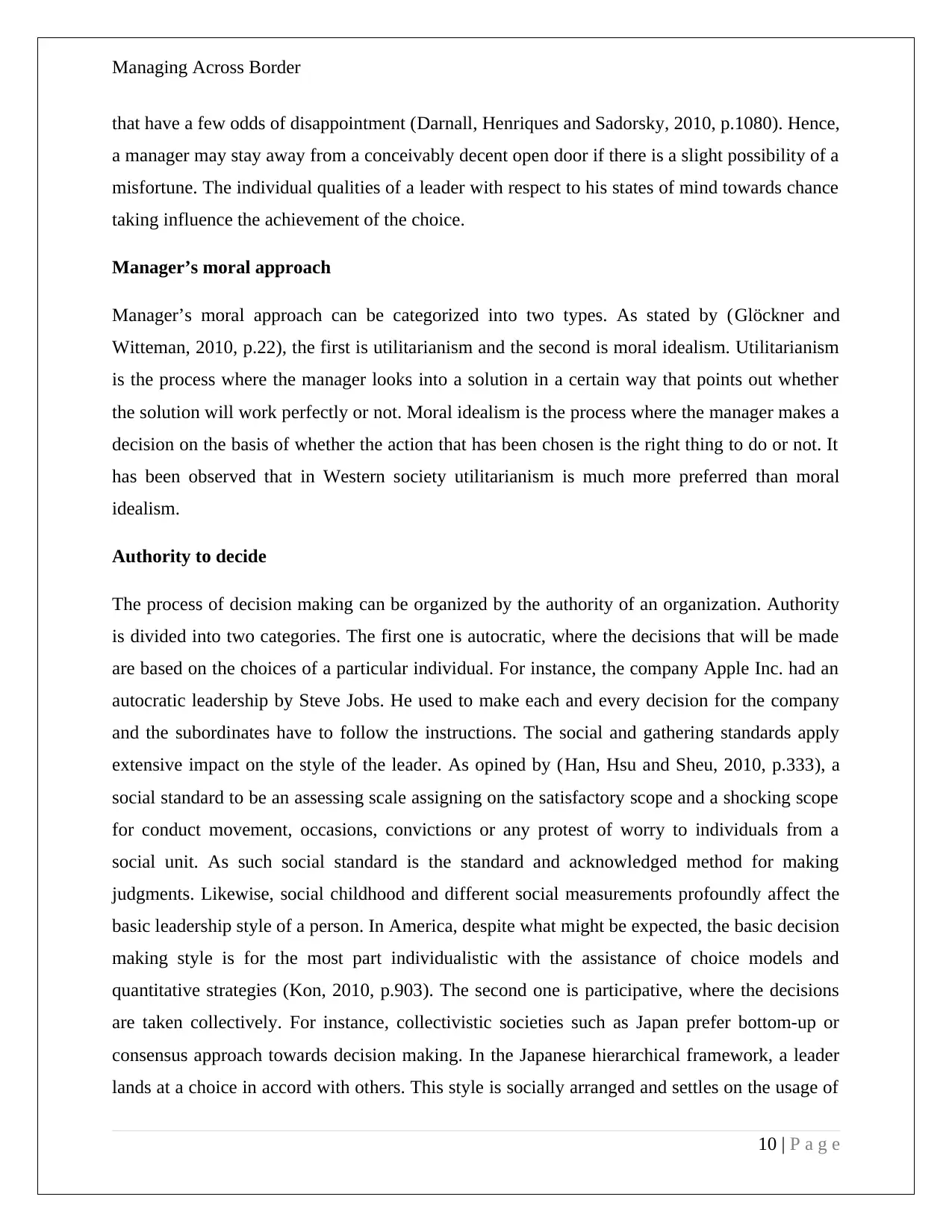
Managing Across Border
that have a few odds of disappointment (Darnall, Henriques and Sadorsky, 2010, p.1080). Hence,
a manager may stay away from a conceivably decent open door if there is a slight possibility of a
misfortune. The individual qualities of a leader with respect to his states of mind towards chance
taking influence the achievement of the choice.
Manager’s moral approach
Manager’s moral approach can be categorized into two types. As stated by (Glöckner and
Witteman, 2010, p.22), the first is utilitarianism and the second is moral idealism. Utilitarianism
is the process where the manager looks into a solution in a certain way that points out whether
the solution will work perfectly or not. Moral idealism is the process where the manager makes a
decision on the basis of whether the action that has been chosen is the right thing to do or not. It
has been observed that in Western society utilitarianism is much more preferred than moral
idealism.
Authority to decide
The process of decision making can be organized by the authority of an organization. Authority
is divided into two categories. The first one is autocratic, where the decisions that will be made
are based on the choices of a particular individual. For instance, the company Apple Inc. had an
autocratic leadership by Steve Jobs. He used to make each and every decision for the company
and the subordinates have to follow the instructions. The social and gathering standards apply
extensive impact on the style of the leader. As opined by (Han, Hsu and Sheu, 2010, p.333), a
social standard to be an assessing scale assigning on the satisfactory scope and a shocking scope
for conduct movement, occasions, convictions or any protest of worry to individuals from a
social unit. As such social standard is the standard and acknowledged method for making
judgments. Likewise, social childhood and different social measurements profoundly affect the
basic leadership style of a person. In America, despite what might be expected, the basic decision
making style is for the most part individualistic with the assistance of choice models and
quantitative strategies (Kon, 2010, p.903). The second one is participative, where the decisions
are taken collectively. For instance, collectivistic societies such as Japan prefer bottom-up or
consensus approach towards decision making. In the Japanese hierarchical framework, a leader
lands at a choice in accord with others. This style is socially arranged and settles on the usage of
10 | P a g e
that have a few odds of disappointment (Darnall, Henriques and Sadorsky, 2010, p.1080). Hence,
a manager may stay away from a conceivably decent open door if there is a slight possibility of a
misfortune. The individual qualities of a leader with respect to his states of mind towards chance
taking influence the achievement of the choice.
Manager’s moral approach
Manager’s moral approach can be categorized into two types. As stated by (Glöckner and
Witteman, 2010, p.22), the first is utilitarianism and the second is moral idealism. Utilitarianism
is the process where the manager looks into a solution in a certain way that points out whether
the solution will work perfectly or not. Moral idealism is the process where the manager makes a
decision on the basis of whether the action that has been chosen is the right thing to do or not. It
has been observed that in Western society utilitarianism is much more preferred than moral
idealism.
Authority to decide
The process of decision making can be organized by the authority of an organization. Authority
is divided into two categories. The first one is autocratic, where the decisions that will be made
are based on the choices of a particular individual. For instance, the company Apple Inc. had an
autocratic leadership by Steve Jobs. He used to make each and every decision for the company
and the subordinates have to follow the instructions. The social and gathering standards apply
extensive impact on the style of the leader. As opined by (Han, Hsu and Sheu, 2010, p.333), a
social standard to be an assessing scale assigning on the satisfactory scope and a shocking scope
for conduct movement, occasions, convictions or any protest of worry to individuals from a
social unit. As such social standard is the standard and acknowledged method for making
judgments. Likewise, social childhood and different social measurements profoundly affect the
basic leadership style of a person. In America, despite what might be expected, the basic decision
making style is for the most part individualistic with the assistance of choice models and
quantitative strategies (Kon, 2010, p.903). The second one is participative, where the decisions
are taken collectively. For instance, collectivistic societies such as Japan prefer bottom-up or
consensus approach towards decision making. In the Japanese hierarchical framework, a leader
lands at a choice in accord with others. This style is socially arranged and settles on the usage of
10 | P a g e
Secure Best Marks with AI Grader
Need help grading? Try our AI Grader for instant feedback on your assignments.
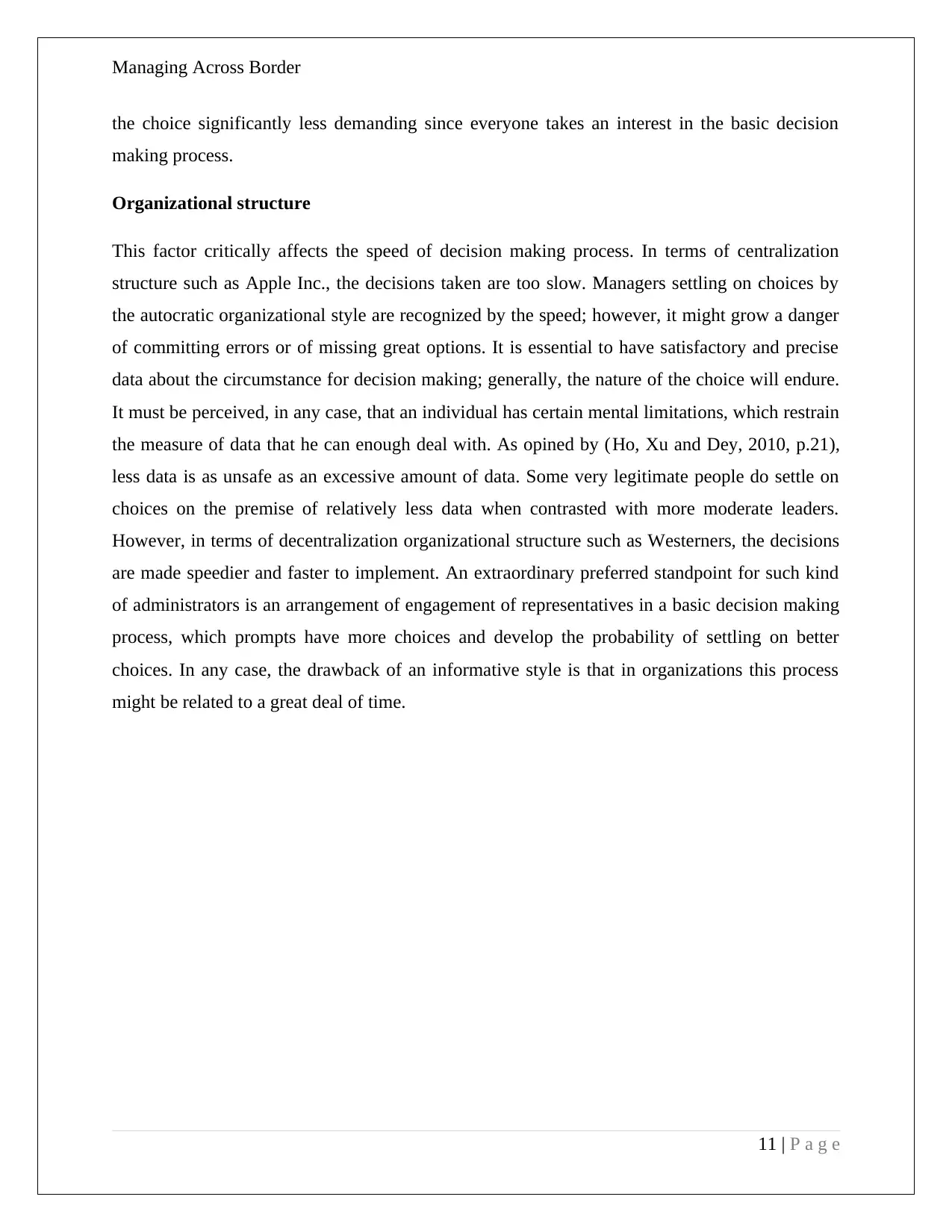
Managing Across Border
the choice significantly less demanding since everyone takes an interest in the basic decision
making process.
Organizational structure
This factor critically affects the speed of decision making process. In terms of centralization
structure such as Apple Inc., the decisions taken are too slow. Managers settling on choices by
the autocratic organizational style are recognized by the speed; however, it might grow a danger
of committing errors or of missing great options. It is essential to have satisfactory and precise
data about the circumstance for decision making; generally, the nature of the choice will endure.
It must be perceived, in any case, that an individual has certain mental limitations, which restrain
the measure of data that he can enough deal with. As opined by (Ho, Xu and Dey, 2010, p.21),
less data is as unsafe as an excessive amount of data. Some very legitimate people do settle on
choices on the premise of relatively less data when contrasted with more moderate leaders.
However, in terms of decentralization organizational structure such as Westerners, the decisions
are made speedier and faster to implement. An extraordinary preferred standpoint for such kind
of administrators is an arrangement of engagement of representatives in a basic decision making
process, which prompts have more choices and develop the probability of settling on better
choices. In any case, the drawback of an informative style is that in organizations this process
might be related to a great deal of time.
11 | P a g e
the choice significantly less demanding since everyone takes an interest in the basic decision
making process.
Organizational structure
This factor critically affects the speed of decision making process. In terms of centralization
structure such as Apple Inc., the decisions taken are too slow. Managers settling on choices by
the autocratic organizational style are recognized by the speed; however, it might grow a danger
of committing errors or of missing great options. It is essential to have satisfactory and precise
data about the circumstance for decision making; generally, the nature of the choice will endure.
It must be perceived, in any case, that an individual has certain mental limitations, which restrain
the measure of data that he can enough deal with. As opined by (Ho, Xu and Dey, 2010, p.21),
less data is as unsafe as an excessive amount of data. Some very legitimate people do settle on
choices on the premise of relatively less data when contrasted with more moderate leaders.
However, in terms of decentralization organizational structure such as Westerners, the decisions
are made speedier and faster to implement. An extraordinary preferred standpoint for such kind
of administrators is an arrangement of engagement of representatives in a basic decision making
process, which prompts have more choices and develop the probability of settling on better
choices. In any case, the drawback of an informative style is that in organizations this process
might be related to a great deal of time.
11 | P a g e
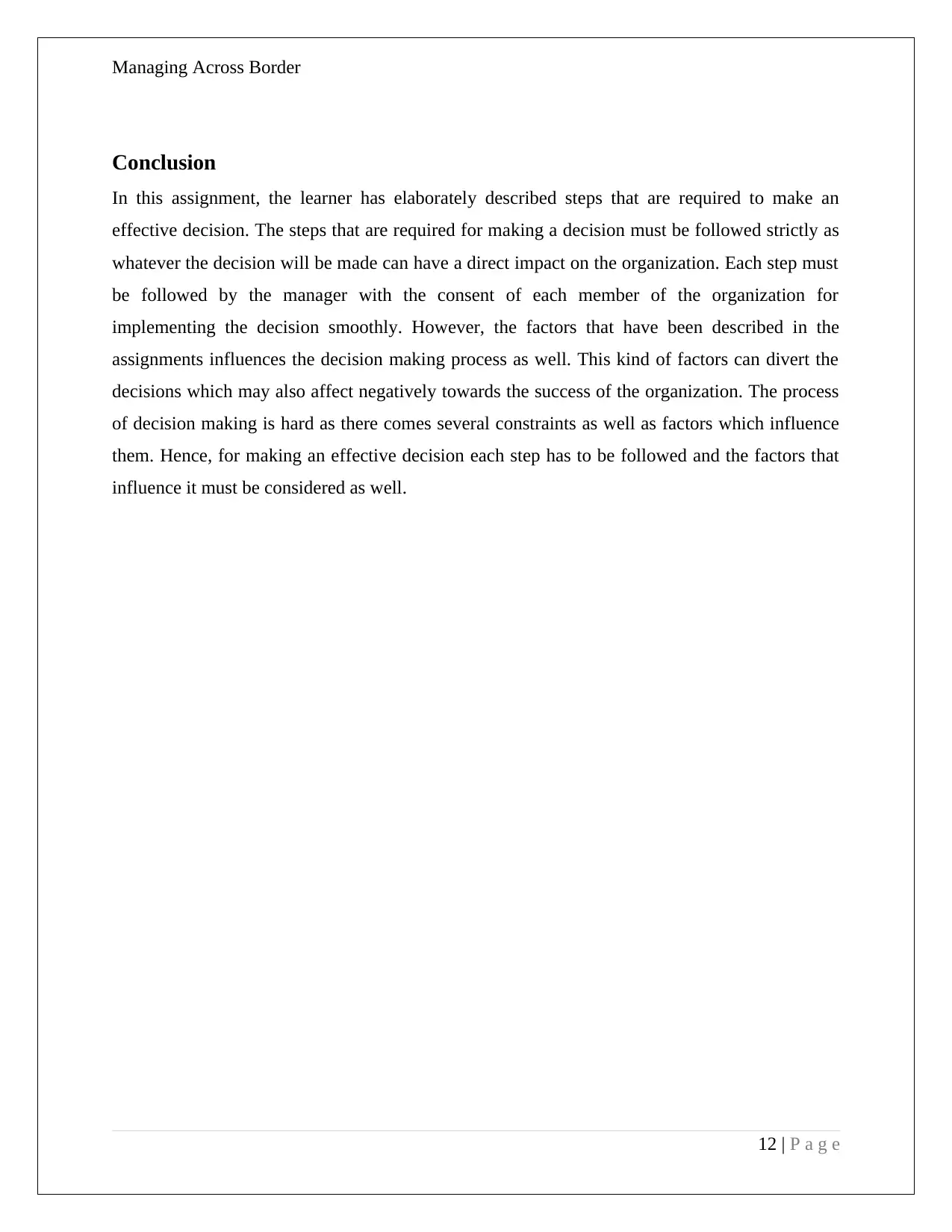
Managing Across Border
Conclusion
In this assignment, the learner has elaborately described steps that are required to make an
effective decision. The steps that are required for making a decision must be followed strictly as
whatever the decision will be made can have a direct impact on the organization. Each step must
be followed by the manager with the consent of each member of the organization for
implementing the decision smoothly. However, the factors that have been described in the
assignments influences the decision making process as well. This kind of factors can divert the
decisions which may also affect negatively towards the success of the organization. The process
of decision making is hard as there comes several constraints as well as factors which influence
them. Hence, for making an effective decision each step has to be followed and the factors that
influence it must be considered as well.
12 | P a g e
Conclusion
In this assignment, the learner has elaborately described steps that are required to make an
effective decision. The steps that are required for making a decision must be followed strictly as
whatever the decision will be made can have a direct impact on the organization. Each step must
be followed by the manager with the consent of each member of the organization for
implementing the decision smoothly. However, the factors that have been described in the
assignments influences the decision making process as well. This kind of factors can divert the
decisions which may also affect negatively towards the success of the organization. The process
of decision making is hard as there comes several constraints as well as factors which influence
them. Hence, for making an effective decision each step has to be followed and the factors that
influence it must be considered as well.
12 | P a g e
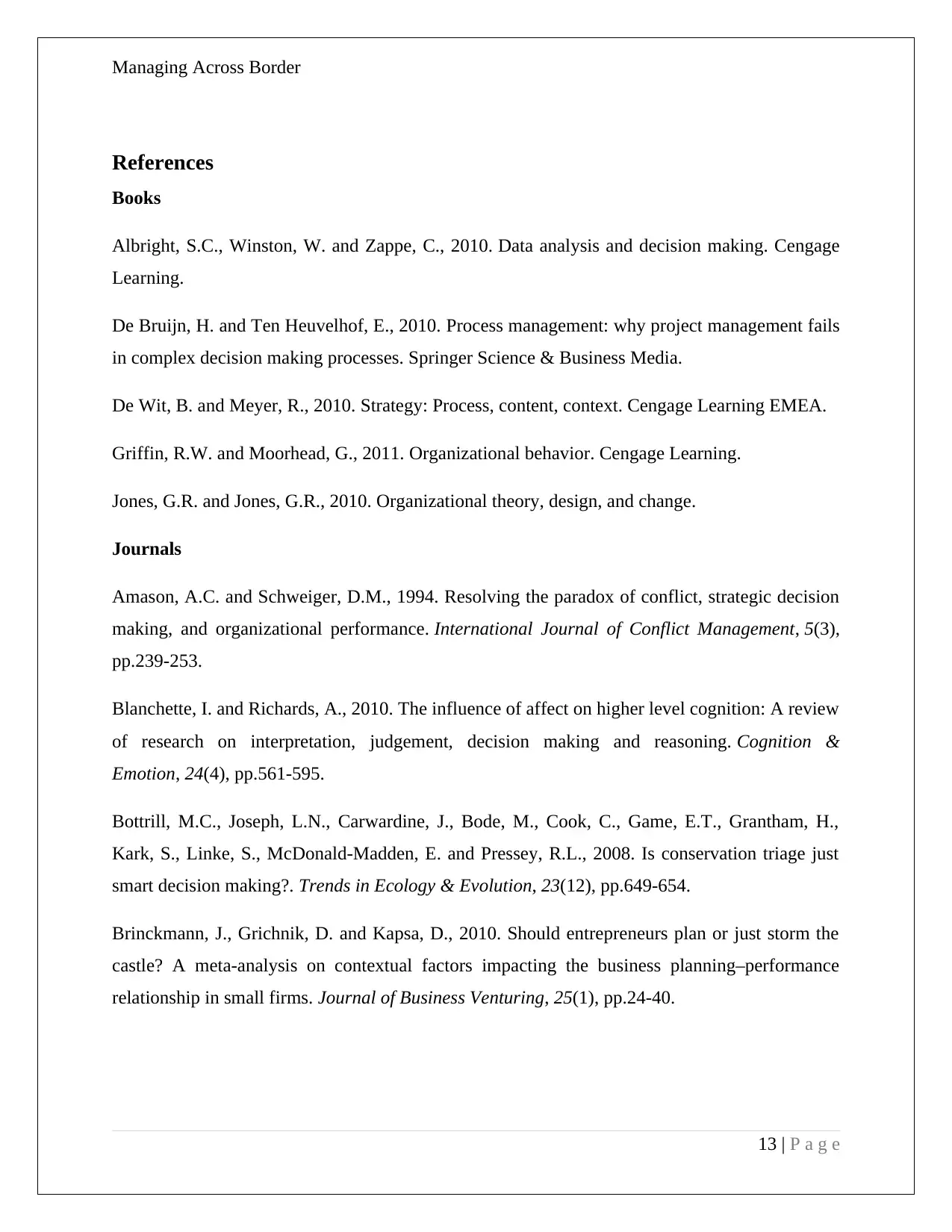
Managing Across Border
References
Books
Albright, S.C., Winston, W. and Zappe, C., 2010. Data analysis and decision making. Cengage
Learning.
De Bruijn, H. and Ten Heuvelhof, E., 2010. Process management: why project management fails
in complex decision making processes. Springer Science & Business Media.
De Wit, B. and Meyer, R., 2010. Strategy: Process, content, context. Cengage Learning EMEA.
Griffin, R.W. and Moorhead, G., 2011. Organizational behavior. Cengage Learning.
Jones, G.R. and Jones, G.R., 2010. Organizational theory, design, and change.
Journals
Amason, A.C. and Schweiger, D.M., 1994. Resolving the paradox of conflict, strategic decision
making, and organizational performance. International Journal of Conflict Management, 5(3),
pp.239-253.
Blanchette, I. and Richards, A., 2010. The influence of affect on higher level cognition: A review
of research on interpretation, judgement, decision making and reasoning. Cognition &
Emotion, 24(4), pp.561-595.
Bottrill, M.C., Joseph, L.N., Carwardine, J., Bode, M., Cook, C., Game, E.T., Grantham, H.,
Kark, S., Linke, S., McDonald-Madden, E. and Pressey, R.L., 2008. Is conservation triage just
smart decision making?. Trends in Ecology & Evolution, 23(12), pp.649-654.
Brinckmann, J., Grichnik, D. and Kapsa, D., 2010. Should entrepreneurs plan or just storm the
castle? A meta-analysis on contextual factors impacting the business planning–performance
relationship in small firms. Journal of Business Venturing, 25(1), pp.24-40.
13 | P a g e
References
Books
Albright, S.C., Winston, W. and Zappe, C., 2010. Data analysis and decision making. Cengage
Learning.
De Bruijn, H. and Ten Heuvelhof, E., 2010. Process management: why project management fails
in complex decision making processes. Springer Science & Business Media.
De Wit, B. and Meyer, R., 2010. Strategy: Process, content, context. Cengage Learning EMEA.
Griffin, R.W. and Moorhead, G., 2011. Organizational behavior. Cengage Learning.
Jones, G.R. and Jones, G.R., 2010. Organizational theory, design, and change.
Journals
Amason, A.C. and Schweiger, D.M., 1994. Resolving the paradox of conflict, strategic decision
making, and organizational performance. International Journal of Conflict Management, 5(3),
pp.239-253.
Blanchette, I. and Richards, A., 2010. The influence of affect on higher level cognition: A review
of research on interpretation, judgement, decision making and reasoning. Cognition &
Emotion, 24(4), pp.561-595.
Bottrill, M.C., Joseph, L.N., Carwardine, J., Bode, M., Cook, C., Game, E.T., Grantham, H.,
Kark, S., Linke, S., McDonald-Madden, E. and Pressey, R.L., 2008. Is conservation triage just
smart decision making?. Trends in Ecology & Evolution, 23(12), pp.649-654.
Brinckmann, J., Grichnik, D. and Kapsa, D., 2010. Should entrepreneurs plan or just storm the
castle? A meta-analysis on contextual factors impacting the business planning–performance
relationship in small firms. Journal of Business Venturing, 25(1), pp.24-40.
13 | P a g e
Paraphrase This Document
Need a fresh take? Get an instant paraphrase of this document with our AI Paraphraser
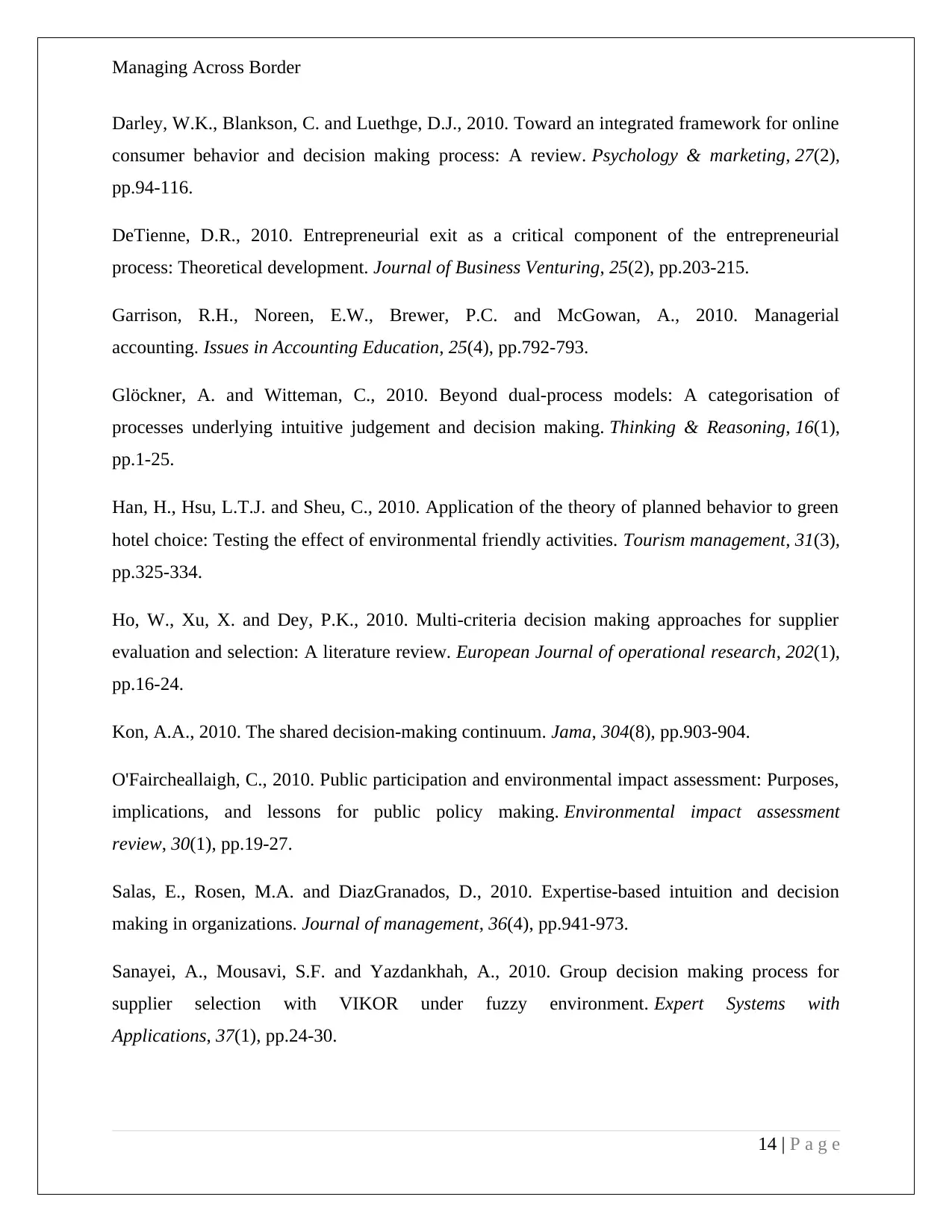
Managing Across Border
Darley, W.K., Blankson, C. and Luethge, D.J., 2010. Toward an integrated framework for online
consumer behavior and decision making process: A review. Psychology & marketing, 27(2),
pp.94-116.
DeTienne, D.R., 2010. Entrepreneurial exit as a critical component of the entrepreneurial
process: Theoretical development. Journal of Business Venturing, 25(2), pp.203-215.
Garrison, R.H., Noreen, E.W., Brewer, P.C. and McGowan, A., 2010. Managerial
accounting. Issues in Accounting Education, 25(4), pp.792-793.
Glöckner, A. and Witteman, C., 2010. Beyond dual-process models: A categorisation of
processes underlying intuitive judgement and decision making. Thinking & Reasoning, 16(1),
pp.1-25.
Han, H., Hsu, L.T.J. and Sheu, C., 2010. Application of the theory of planned behavior to green
hotel choice: Testing the effect of environmental friendly activities. Tourism management, 31(3),
pp.325-334.
Ho, W., Xu, X. and Dey, P.K., 2010. Multi-criteria decision making approaches for supplier
evaluation and selection: A literature review. European Journal of operational research, 202(1),
pp.16-24.
Kon, A.A., 2010. The shared decision-making continuum. Jama, 304(8), pp.903-904.
O'Faircheallaigh, C., 2010. Public participation and environmental impact assessment: Purposes,
implications, and lessons for public policy making. Environmental impact assessment
review, 30(1), pp.19-27.
Salas, E., Rosen, M.A. and DiazGranados, D., 2010. Expertise-based intuition and decision
making in organizations. Journal of management, 36(4), pp.941-973.
Sanayei, A., Mousavi, S.F. and Yazdankhah, A., 2010. Group decision making process for
supplier selection with VIKOR under fuzzy environment. Expert Systems with
Applications, 37(1), pp.24-30.
14 | P a g e
Darley, W.K., Blankson, C. and Luethge, D.J., 2010. Toward an integrated framework for online
consumer behavior and decision making process: A review. Psychology & marketing, 27(2),
pp.94-116.
DeTienne, D.R., 2010. Entrepreneurial exit as a critical component of the entrepreneurial
process: Theoretical development. Journal of Business Venturing, 25(2), pp.203-215.
Garrison, R.H., Noreen, E.W., Brewer, P.C. and McGowan, A., 2010. Managerial
accounting. Issues in Accounting Education, 25(4), pp.792-793.
Glöckner, A. and Witteman, C., 2010. Beyond dual-process models: A categorisation of
processes underlying intuitive judgement and decision making. Thinking & Reasoning, 16(1),
pp.1-25.
Han, H., Hsu, L.T.J. and Sheu, C., 2010. Application of the theory of planned behavior to green
hotel choice: Testing the effect of environmental friendly activities. Tourism management, 31(3),
pp.325-334.
Ho, W., Xu, X. and Dey, P.K., 2010. Multi-criteria decision making approaches for supplier
evaluation and selection: A literature review. European Journal of operational research, 202(1),
pp.16-24.
Kon, A.A., 2010. The shared decision-making continuum. Jama, 304(8), pp.903-904.
O'Faircheallaigh, C., 2010. Public participation and environmental impact assessment: Purposes,
implications, and lessons for public policy making. Environmental impact assessment
review, 30(1), pp.19-27.
Salas, E., Rosen, M.A. and DiazGranados, D., 2010. Expertise-based intuition and decision
making in organizations. Journal of management, 36(4), pp.941-973.
Sanayei, A., Mousavi, S.F. and Yazdankhah, A., 2010. Group decision making process for
supplier selection with VIKOR under fuzzy environment. Expert Systems with
Applications, 37(1), pp.24-30.
14 | P a g e
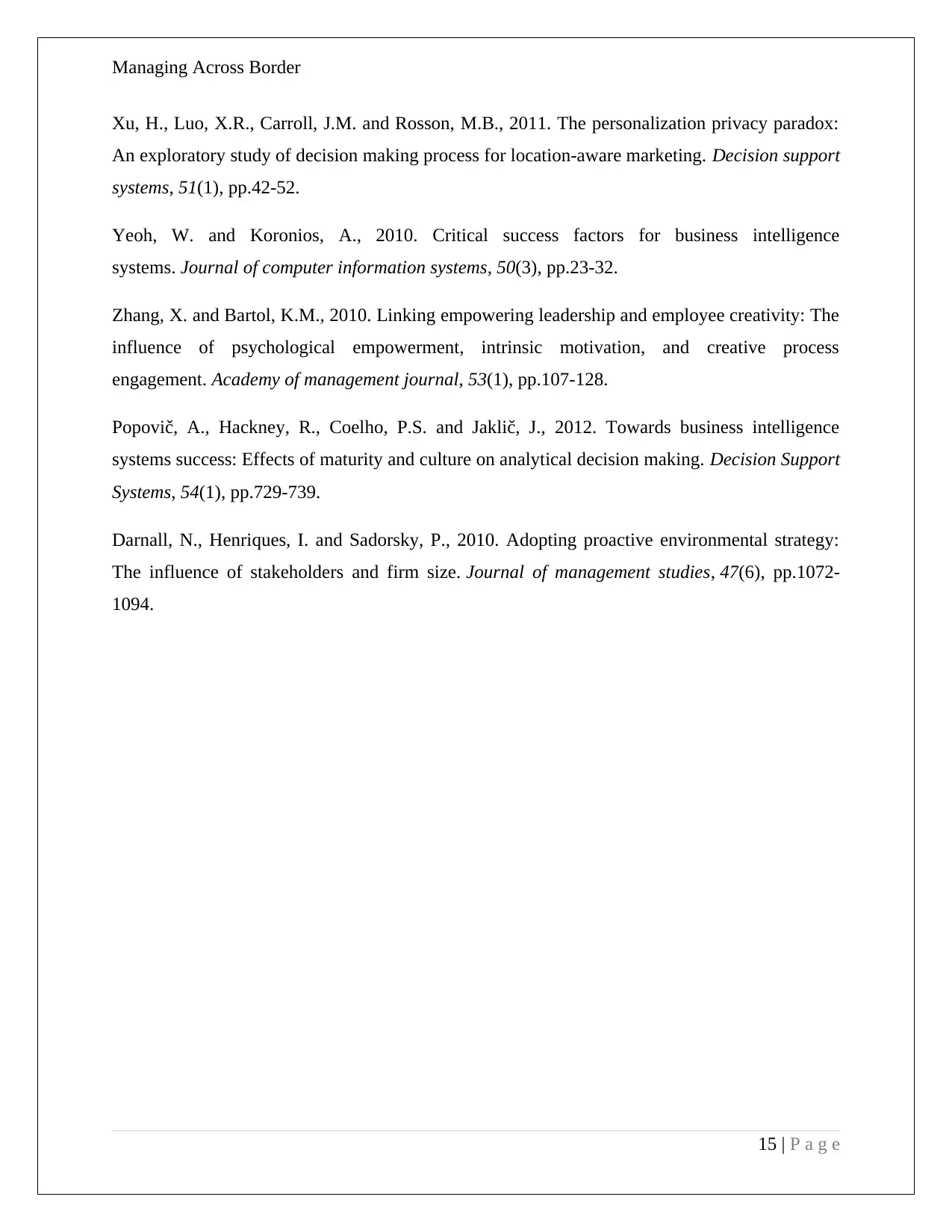
Managing Across Border
Xu, H., Luo, X.R., Carroll, J.M. and Rosson, M.B., 2011. The personalization privacy paradox:
An exploratory study of decision making process for location-aware marketing. Decision support
systems, 51(1), pp.42-52.
Yeoh, W. and Koronios, A., 2010. Critical success factors for business intelligence
systems. Journal of computer information systems, 50(3), pp.23-32.
Zhang, X. and Bartol, K.M., 2010. Linking empowering leadership and employee creativity: The
influence of psychological empowerment, intrinsic motivation, and creative process
engagement. Academy of management journal, 53(1), pp.107-128.
Popovič, A., Hackney, R., Coelho, P.S. and Jaklič, J., 2012. Towards business intelligence
systems success: Effects of maturity and culture on analytical decision making. Decision Support
Systems, 54(1), pp.729-739.
Darnall, N., Henriques, I. and Sadorsky, P., 2010. Adopting proactive environmental strategy:
The influence of stakeholders and firm size. Journal of management studies, 47(6), pp.1072-
1094.
15 | P a g e
Xu, H., Luo, X.R., Carroll, J.M. and Rosson, M.B., 2011. The personalization privacy paradox:
An exploratory study of decision making process for location-aware marketing. Decision support
systems, 51(1), pp.42-52.
Yeoh, W. and Koronios, A., 2010. Critical success factors for business intelligence
systems. Journal of computer information systems, 50(3), pp.23-32.
Zhang, X. and Bartol, K.M., 2010. Linking empowering leadership and employee creativity: The
influence of psychological empowerment, intrinsic motivation, and creative process
engagement. Academy of management journal, 53(1), pp.107-128.
Popovič, A., Hackney, R., Coelho, P.S. and Jaklič, J., 2012. Towards business intelligence
systems success: Effects of maturity and culture on analytical decision making. Decision Support
Systems, 54(1), pp.729-739.
Darnall, N., Henriques, I. and Sadorsky, P., 2010. Adopting proactive environmental strategy:
The influence of stakeholders and firm size. Journal of management studies, 47(6), pp.1072-
1094.
15 | P a g e
1 out of 15
Related Documents
Your All-in-One AI-Powered Toolkit for Academic Success.
+13062052269
info@desklib.com
Available 24*7 on WhatsApp / Email
![[object Object]](/_next/static/media/star-bottom.7253800d.svg)
Unlock your academic potential
© 2024 | Zucol Services PVT LTD | All rights reserved.





